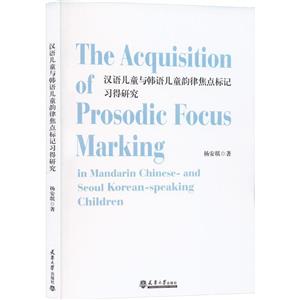掃一掃
關注中圖網
官方微博
本類五星書更多>
-
>
妙相梵容
-
>
基立爾蒙文:蒙文
-
>
我的石頭記
-
>
心靈元氣社
-
>
女性生存戰爭
-
>
縣中的孩子 中國縣域教育生態
-
>
(精)人類的明天(八品)
漢語兒童與韓語兒童韻律焦點標記習得研究 版權信息
- ISBN:9787561874646
- 條形碼:9787561874646 ; 978-7-5618-7464-6
- 裝幀:一般膠版紙
- 冊數:暫無
- 重量:暫無
- 所屬分類:>
漢語兒童與韓語兒童韻律焦點標記習得研究 內容簡介
本書是一本關注兒童語言發展的英文學術專著。在本書涉及的研究中,研究者調查了母語為漢語(普通話)的中國兒童和母語為(標準)韓語的韓國兒童在不同年齡段如何使用韻律在其產出的語言中標記焦點。作者在語言類型學框架下對比中、韓兩國兒童語言韻律的發展路徑,從跨語言的視角討論了不同語言韻律系統的差異給兒童語言習得帶來了不同挑戰、塑造了不同的具體發展路徑。本書內容可以為關心兒童語言發展的科研工作者和教育工作者提供有價值的信息,亦可為兒童心理、認知發展相關研究提供語言層面的參數,對于了解兒童語言發展過程中的共性和特性有重要意義。
漢語兒童與韓語兒童韻律焦點標記習得研究 目錄
CHAPTER 1 Introduction
1.1 Preliminaries
1.2 Motivation
1.3 Focus, focus types, and prosodic encoding of focus
1.4 Past work on the acquisition of prosodic focus marking
1.4.1 Prosodic focus marking in Germanic languages
1.4.2 The acquisition of phonological focus marking in Germanic languages
1.4.3 Phonetic focus marking in children
1.4.4 Summarising the acquisition of prosodic focus marking
1.5 Prosodic focus marking in Mandarin and Korean
1.5.1 Prosody and prosodic focus marking in Mandarin
1.5.2 Prosody and prosodic focus marking in Korean
1.6 Hypotheses and predictions
1.7 Dissertation outline
CHAPTER 2 Prosodic realisation of focus in Mandarin Chinese
2.1 Introduction
2.2 Method
2.2.1 Participants
2.2.2 The picture-matching task
2.2.3 Experimental materials
2.2.4 Experimental procedure
2.2.5 Prosodic annotation
2.3 Statistical analysis and results
2.3.1 Realisation of narrow focus
2.3.2 Realisation of focus types (Narrow focus vs. broad focus vs. contrastive focus)
2.4 Conclusions
CHAPTER 3 The developmental path to adult-like prosodic focus marking in Mandarin Chinese-speaking children
3.1 Introduction
3.2 Method
3.2.1 Participants
3.2.2 The picture-matching game
3.2.3 Experimental materials
3.2.4 Experimental procedure
3.2.5 Prosodic annotation
3.3 Statistical analysis and results
3.3.1 Realisation of narrow focus
3.3.2 Realisation of focus types
3.4 Discussion and conclusions
CHAPTER 4 Prosodic realisation of focus in Seoul Korean: the use of prosodicphrasing and phonetic cues
4.1 Introduction
4.1.1 Phonological and phonetic focus marking in Korean
4.1.2 Limitations of past work
4.1.3 The current study
4.2 Method
4.2.1 Participants
4.2.2 The picture-matching task
4.2.3 Experimental materials
4.2.4 Experimental procedure
4.3 Analysis and results, part 1: prosodic phrasing
4.3.1 Prosodic annotation
4.3.2 Results on the varying of phrasal boundaries
4.4 Analysis and results, part 2: the varying of phonetic cues
4.4.1 Phonetic annotation
4.4.2 Statistical analysis and results
4.5 Conclusions
CHAPTER 5 Prosodic focus marking in Seoul Korean-speaking children: the use of prosodic phrasing
5.1 Introduction
5.1.1 Prosodic encoding of focus across languages
5.1.2 The acquisition of prosodic focus marking
5.1.3 Prosodic focus marking in Korean adult speech
5.1.4 The current study
5.2 Method
5.2.1 Participants
5.2.2 The picture-matching game
5.2.3 Experimental materials
5.2.4 Experimental procedure
5.2.5 Prosodic annotation
5.3 Statistical analyses and results
5.3.1 Narrow focus vs. pre-focus (NF-m vs. NF-f)
5.3.2 Narrow focus vs. post-focus (NF-m vs. NF-i)
5.3.3 Narrow focus vs. broad focus (NF-m vs. BF)
5.3.4 Narrow focus vs. contrastive focus (NF-m vs. CF-m)
5.4 Discussion and conclusions
CHAPTER 6 Prosodic focus marking in Seoul Korean-speaking chidren: the use of duration-and pitch-related phonetic cues
6.1 Introduction
6.1.1 The acquisition of phonetic focus marking
6.1.2 Phonetic focus marking in Korean adult speech
6.1.3 The current study
6.2 Method
6.2.1 Participants
6.2.2 The picture-matching game
6.2.3 Experimental materials
6.2.4 Experimental procedure
6.2.5 Sentence selection
6.2.6 Phonetic annotation
6.3 Statistical analysis and results
6.3.1 Realisation of narrow focus
6.3.2 Realisation of focus types
6.4 Discussion and conclusions
CHAPTER 7 General discussion and conclusions
7.1 Introduction
7.2 Summary of the main findings
7.2.1 The acquisition of prosodic focus marking in Mandarin
7.2.2 The acquisition of prosodic focus marking in Korean
7.2.3 The developmental paths to adult-like prosodic focus marking
7.3 Hypotheses and predictions revisited
7.4 Limitations and directions for future studies
REFERENCES
APPENDICES
Appendix A: Mandarin speakers
Appendix B: Mandarin sentences
Appendix C: Korean speakers
Appendix D: Korean sentences
SAMENVATTING
ACKNOWLEDGEMENTS
CURRICULUM VITAE
展開全部
漢語兒童與韓語兒童韻律焦點標記習得研究 作者簡介
楊安琪,1986年出生于中國河北。2005年至2009年就讀于浙江農林大學英語語言文學專業。2010年至2011年,她在約克大學(University of York)攻讀語言學碩士學位,在那里她對音韻學和語言習得的興趣開始增長。在完成碩士學業后,她獲得了烏得勒支大學烏得勒支語言研究所的博士職位。本文是安琪2012年至2017年在烏得勒支大學攻讀博士學位期間的工作成果。
書友推薦
- >
自卑與超越
- >
月亮虎
- >
回憶愛瑪儂
- >
新文學天穹兩巨星--魯迅與胡適/紅燭學術叢書(紅燭學術叢書)
- >
小考拉的故事-套裝共3冊
- >
李白與唐代文化
- >
姑媽的寶刀
- >
山海經
本類暢銷


















